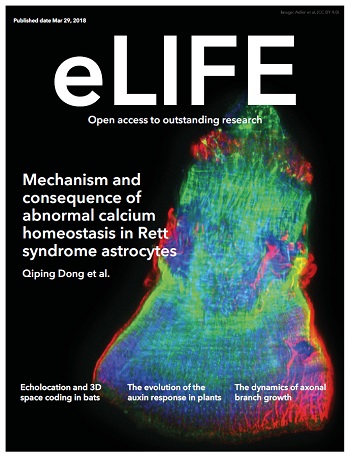Limited column formation in the embryonic growth plate implies divergent growth mechanisms during pre- and postnatal bone development
IF 6.4
1区 生物学
Q1 BIOLOGY
引用次数: 0
Abstract
Chondrocyte columns, which are a hallmark of growth plate architecture, play a central role in bone elongation. Columns are formed by clonal expansion following rotation of the division plane, resulting in a stack of cells oriented parallel to the growth direction. In this work, we analyzed hundreds of Confetti multicolor clones in growth plates of mouse embryos using a pipeline comprising 3D imaging and algorithms for morphometric analysis. Surprisingly, analysis of the elevation angles between neighboring pairs of cells revealed that most cells did not display the typical stacking pattern associated with column formation, implying incomplete rotation of the division plane. Morphological analysis revealed that although embryonic clones were elongated, they formed clusters oriented perpendicular to the growth direction. Analysis of growth plates of postnatal mice revealed both complex columns, composed of ordered and disordered cell stacks, and small, disorganized clusters located in the outer edges. Finally, correlation between the temporal dynamics of the ratios between clusters and columns and between bone elongation and expansion suggests that clusters may promote expansion, whereas columns support elongation. Overall, our findings support the idea that modulations of division plane rotation of proliferating chondrocytes determines the formation of either clusters or columns, a multifunctional design that regulates morphogenesis throughout pre- and postnatal bone growth. Broadly, this work provides a new understanding of the cellular mechanisms underlying growth plate activity and bone elongation during development.胚胎生长板中有限的骨柱形成意味着出生前和出生后骨骼发育过程中存在不同的生长机制
软骨细胞柱是生长板结构的标志,在骨骼伸长中发挥着核心作用。软骨细胞柱是在分裂平面旋转后通过克隆扩增形成的,细胞堆积的方向与生长方向平行。在这项工作中,我们利用三维成像和形态计量分析算法分析了小鼠胚胎生长板中的数百个 Confetti 多色克隆。令人惊讶的是,通过分析相邻细胞对之间的仰角发现,大多数细胞并没有显示出与柱形成相关的典型堆叠模式,这意味着分裂面没有完全旋转。形态学分析表明,虽然胚胎克隆是伸长的,但它们形成的细胞簇方向与生长方向垂直。对出生后小鼠生长板的分析表明,既有由有序和无序细胞堆组成的复杂柱,也有位于外缘的小而无序的细胞簇。最后,骨簇与骨柱之间的比例以及骨伸长与骨膨胀之间的时间动态相关性表明,骨簇可能促进骨膨胀,而骨柱则支持骨伸长。总之,我们的研究结果支持这样一种观点,即增殖软骨细胞分裂平面旋转的调节决定了骨簇或骨柱的形成,这种多功能设计调节了整个出生前和出生后骨生长过程中的形态发生。从广义上讲,这项研究为人们提供了对发育过程中生长板活动和骨伸长的细胞机制的新认识。
本文章由计算机程序翻译,如有差异,请以英文原文为准。
求助全文
约1分钟内获得全文
求助全文
来源期刊

eLife
BIOLOGY-
CiteScore
12.90
自引率
3.90%
发文量
3122
审稿时长
17 weeks
期刊介绍:
eLife is a distinguished, not-for-profit, peer-reviewed open access scientific journal that specializes in the fields of biomedical and life sciences. eLife is known for its selective publication process, which includes a variety of article types such as:
Research Articles: Detailed reports of original research findings.
Short Reports: Concise presentations of significant findings that do not warrant a full-length research article.
Tools and Resources: Descriptions of new tools, technologies, or resources that facilitate scientific research.
Research Advances: Brief reports on significant scientific advancements that have immediate implications for the field.
Scientific Correspondence: Short communications that comment on or provide additional information related to published articles.
Review Articles: Comprehensive overviews of a specific topic or field within the life sciences.
文献相关原料
| 公司名称 | 产品信息 | 采购帮参考价格 |
|---|
 求助内容:
求助内容: 应助结果提醒方式:
应助结果提醒方式:


